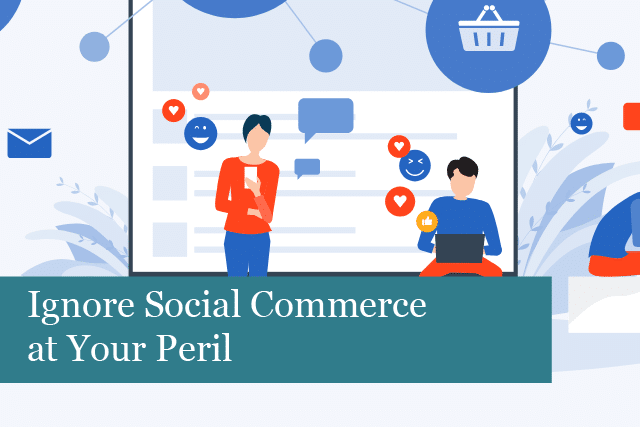
As 2022 began, everyone believed that e-commerce would continue to grow. And they were right. In 2022, ecommerce has grown from 10% (five years ago) to 20.4% of global retail sales by the end of 2022.
The main driver behind ecommerce has been social commerce.
What is Social Commerce?
Social commerce is the use of social media platforms (such as Facebook & Instagram) to market and sell products and services. This selling model makes it easy for customers to complete their purchases without leaving their social media apps.
Customers can use social commerce for the following:
- Discover new brands
- Research products
- Purchase items
- Interact with customer support
In other words, social commerce has become the most convenient and interactive way to shop. And these may be the reasons social commerce has become so popular. Estimates show that the global value of social commerce will reach about $2.9 trillion by 2026!
Social commerce is different from traditional social media marketing strategies, where shoppers may view a brand’s content and visit its website and start shopping. However, some social platforms, such as Facebook Shop or Instagram Shops act like virtual storefronts.
Social commerce is thriving because social media usage is always increasing. The main customers behind this trend may surprise you—it’s Gen Z and Millennials. These customers are the most likely social platform users to have made at least one purchase via a social platform.
What’s more, social commerce makes it easy to promote and sell products. As you scroll through Facebook, you may come across many skin care product ads with the “Shop Now” button shown prominently. All a customer has to do is add the product to their cart and checkout within the app.
What’s the Difference Between Social Commerce and Ecommerce?
Social commerce and ecommerce are not the same. Ecommerce means hopping that takes place on a website or a branded app. These sites allow customers to access these sites on any device that has Internet access.
On the other hand, social commerce is a variation of ecommerce, which describes customers making purchases within social media platforms. Every part of the process, including research and checking out, happens within the social platform.
Why Should You Try Social Commerce?
Social commerce offers many benefits. So, if you’re not sure creating a social media shop is right for you, read the following as to why social commerce may be a great option for your business.
Social Commerce Makes Shopping a Social Experience
Shopping on social media makes the shopping experience more interactive than it is on traditional ecommerce sites. Customers can easily ask their friends about purchases, show off what they’ve bought, comment on their friends’ purchases, and more.
Social commerce makes shopping more fun for everyone. And what do shoppers do when they’re having fun making purchases? They may buy even more, resulting in higher conversions and revenue for your business.
Social Commerce Removes Friction
Social commerce makes shopping so easy there’s less friction than using ecommerce sites. It’s never been easier to make a purchase and follow your customers’ journey from beginning to end.
On the other hand, to make a purchase on an ecommerce site, it’s necessary to click on an ad and go from there to your website. Then the customer needs to add the product to their shopping card, fill in their credit card information, and more. There are more steps to follow than there are for customers who use social commerce to make their purchases.
Social Commerce Makes it Easy to Get Feedback
As a retailer or seller, social commerce offers a great way to collect feedback. Customers can quickly and easily tell you how they feel about your products. They explain their likes and dislikes easily.
It’s also possible to ask your audience to vote and make comments on product development, inventory decisions, and more.
On social media, it’s easier to gather clear data about who customers are and chat with them via comments or direct messages to get their personal insights. You can use this data to deliver personalized customer service and improve your customer experience. It’s a win-win situation.
It’s Easier to Sell to Highly Targeted Audiences
There’s a vast amount of customer data on social media platforms, making this a great opportunity for businesses to target their advertising to highly targeted audience.
Social commerce makes it easy to get more specific about your target audience in a way that’s not possible with traditional ecommerce and marketing strategies.
What are the Best Platforms for Social Commerce?
There are five social platforms that offer social commerce services, including the following.
You can use your Facebook Business Page to share news, connect with fans, and more. What’s the “and more” included? You can use this page to sell some products and boost sales. You can also set up a Facebook Shop!
Facebook Shop offers a customisable platform that allows you to choose collections or goods to feature. You can also customise fonts, images, and colours to fit your brand. Just import an existing product catalog product from your site or create each one from scratch.
Facebook Shops are easy to access from your Facebook Page, Instagram profile, and more.
Instagram also offers shops where visitors can buy products that are featured in photos and videos within the app. And there are numerous ways to sell products on Instagram.
Pinterest was one of the first social media platforms to provide shopping capabilities for their users in 2015. However, the site doesn’t strictly offer social commerce services.
Pinterest does allow you to create “Product Pins” if you have a business account. If customers live in the US and see the “Buy Button,” they can complete their purchase easily and quickly without leaving Pinterest.
Snapchat
Snapchat offers Brand Profiles, which create a native brand experience that makes it easier for users to window shop and make purchases directly from within the app.
Tiktok
Setting up a digital storefront on TikTok is pretty easy and necessary if you’re serious about increasing sales. There are three ways to sell products in a TikTok Shop:
- In-feed videos
- LIVEs
- Product showcase tab
Summing It Up
Engaging shoppers on social commerce platforms is a great way to increase your company’s sales and improve brand awareness.
Social commerce makes it easy for customers to complete sales directly within the app, and it’s an effective sales strategy because it makes the online shopping experience easier from start to finish.
Recommended Posts

Are you making the most of your Microsoft 365 licensing?
4th July 2025


